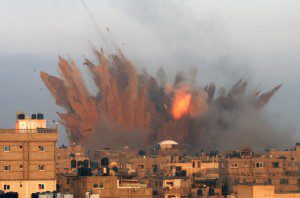
The London School of Economics Middle Eastern Studies Center recently advertised that it is going to hold a symposium on whether the Responsibility to Protect (R2P) Doctrine applies to the current conflict between Israel and Palestine. In particular, it is gathering a cohort of experts to debate R2P’s standing in the conflict, as well as if the norm is the correct framework to be “useful;” however, “useful” for what is not at all clear.
R2P, which holds that states have a responsibility to protect their peoples against gross crimes against humanity, war crimes, genocide and ethnic cleansing, is a contentious and nuanced doctrine. How it applies to the current situation in Gaza is not at all evident, given that this particular situation is not an “easy” case. The conflict is not “internal” in the way that Syria’s civil war is, and as such, few have called upon the parties to clearly uphold their “responsibility to protect.” Thus before anyone rings the death knell for R2P (again), we ought to consider the facts of the case.
First, it is not at all clear how to categorize the conflict. For instance, if one views Gaza as occupied territory, then the Responsibility to Protect civilian populations falls with the occupying power (i.e. Israel), as well as with the de facto controlling authority (Hamas). The majority of the responsibility would lie with the party who can effectively control the territory. Nevertheless, both parties are under an obligation to protect civilians from the four internationally recognized R2P crimes.
This entails that Israel is responsible for the citizens inside of Gaza and Israel. Moreover, it means that Hamas is also responsible for the citizens it endangers. The reality, however, is that both sides have committed wrongs. Rocket fire from Gaza into Israel is indiscriminate and escalatory. That Israel is technologically superior means that it has a higher probability of protecting its population from these attacks. That said, in this scenario Israel is an occupying power, and it is firing missiles into civilian areas and a refugee camp. Israel’s justification that terrorists are using civilians as human shields does not relieve it of its obligation to take due care and uphold the principle of noncombatant immunity. Moreover, claims that all the civilians inside Gaza are not civilians, but should be considered combatants is not only incorrect but also pernicious. Just because one side violates the law, does not mean the other can too. We teach our children that two wrongs do not a right make, in this case it is no different.
In fact, if we follow not merely R2P, but just war principles, then we must seriously question whether one can target adversaries when it is impossible to do so without taking aim at the people. As Michael Walzer famously said regarding levée en masse: “There is, however, a moral argument to be made if this point is reached: the anti-guerilla war can then no longer be fought—and not just because, from a strategic point of view, it can no longer be won. It cannot be fought because it is no longer an anti-guerilla but an anti-social war, a war against an entire people, in which no distinctions would be possible in the actual fighting” (Walzer, 187).
Though Israel would be prohibited from waging war against a people, it still has an internationally recognized right of self-defense, and it would seem rather odd to claim that it must forbear from any defensive action because Hamas perverts the laws and rules of war by using human shields. Which is why there is a moral responsibility for civilian deaths at Hamas’ feet as well. It knew what Israel’s response would be, and it decided to engage regardless. Morally and legally, then, if we view this as occupied territory, both parties are responsible for all the civilian casualties.
However, if one does not view this as occupied territory, then it would be an international armed conflict, which would mean that International Humanitarian Law applies. R2P only applies within domestic states and not between them, for we have already established rules to deal with the regulation of hostilities. If we view this as international armed conflict, then each party may pursue legitimate military objectives, and it is permissible to collaterally kill civilians and damage civilian objects in pursuance of these objectives. However, the deaths or destruction are only permissible when that damage is not intended and not excessive to the military advantage gained by destroying the legitimate target. Israel has so far claimed that its public justification for its uses of force is to eliminating tunnels from Gaza into Israel. This objective is within the bounds of IHL, and it is stating that its actions are not, therefore, illegal.
Of course, the international outcry for the proportion of civilian deaths due to Israel’s bombing and ground campaign is mainly a function of the fact that there are many more (comparatively) civilian Palestinian deaths than Israeli civilian and military deaths. International public opinion sees this as an unfair prosecution of Israel’s right of self-defense. However, IHL is quite permissive in what it allows in terms of collateral damage. Only patently disproportionate uses of force are prohibited, and only direct targeting of civilians is unlawful and would amount to a war crime. Moreover, nothing in international law states that deaths and destructions must be equal, or that warring parties must be of equivalent strength or technological capacity. IHL outlaws unnecessary and indiscriminate uses of force, and most of these judgments are made from the evidence ruling at the time from the commander’s perspective and available intelligence.
It is not at all clear, though, that there is international support to view this as an international armed conflict, and there is also evidence weighing against treating the case as purely a matter of internal conflict within occupied territories. If we look to the former, we have established laws with which to assess the situation. In fact, the International Criminal Court can prosecute individuals from either side for war crimes, given how a referral might be made to the ICC and prosecutorial discretion.
Thus before we can establish if R2P is the “most useful” construct with which to view the conflict, we have to establish what kind of conflict it is. This first step is no easy task, as it amounts to the international community making a decision as to the status of Palestine. Only then, can ask whether any of the four crimes listed as R2P crimes have occurred. Even this assessment, to be frank, is contentious.
R2P’s first version (the 2001 version put forth by the International Commission on Intervention and Sovereignty) does not list war crimes or crimes against humanity as potential just causes for intervention. Only the 2005 “Outcome Document” adopted by the United Nations does. Yet, if one views the 2005 version as the “official” version, then the question of what can be done or where the responsibility falls to when the state is “manifestly failing” to protect the people is the international community, represented by the Security Council. What this means in practice is far from clear, given the political divides between (at least) within the Permanent Five members. Any use of the veto would bar intervention. And this is what R2P was created to address: intervention.
While many claim (myself included) that R2P is more than humanitarian intervention, the reality remains that the prevention and/or capacity building and the post-conflict reconstruction functions of R2P remain underdeveloped and underfunded. The position for a Special Rapporteur on the Responsibility to Protect, once filled by Edward Luck, has now disappeared. And, moreover, many of the Secretary General’s calls for international support for the norm have either fallen on deaf ears, or they have gone to less contentious aspects of the doctrine, like capacity building and early warning. Even the “reaction” portion of the doctrine is still not institutionalized and still merely open to coalitions of the willing.
R2P is a doctrine or a norm in flux, and part of its appeal is that it is not codified and not institutionalized. This allows states to garner support and find consensus in the ambiguities. Nevertheless many of its detractors also, correctly, state that it cannot actually stop gross atrocities. Political will is still the order of the day, and when that is lacking, the blood of civilians will continue to flow. I applaud the LSE’s initiative in looking at the current crisis through a critical lens; however, I hope that it is not wasted effort trudging through the same discussion the international community has with regards to the status of Palestine. Minds need to be put to work thinking of ways to end the conflict and save civilians from harm. For the question is really not: “Why has R2P been neglected in the context of the Israeli-Palestinian conflict?” The question is how we can end the conflict, restore peace and save lives on both sides.
Senior Research Analyst at The Johns Hopkins University Applied Physics Laboratory. Fellow at Brookings Institution and Associate Fellow at University of Cambridge Leverhulme Centre for the Future of Intelligence


Hi Heather,
Just picking up on one aspect of the piece, you say that:
“the International Criminal Court can prosecute individuals from either side for war crimes”.
My understanding of the ICC is that states must be signatories of the Rome Statue and also ratifiers of it to fall under the court’s jurisdiction.
Israel is a signatory, not a ratifier, and Palestine (which isn’t classed as a state under international law) falls into a category of its own.
So unfortunately, surely the ICC cannot prosecute individuals from either side?
What do you think?
ICC:
https://www.icc-cpi.int/EN_Menus/icc/Pages/default.aspx
Hi Pete,
This is true. However, there is also a referral that non-signatory states can be subject to. That is basically if the Security Council refers a situation to the prosecutor. But that requires the SC to agree.